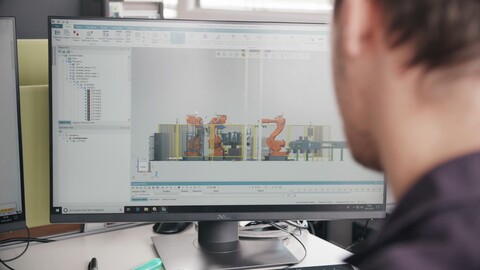What do a ballet performance and virtual commissioning have in common? At first glance, not much, but they are enormously similar in terms of their approach: planning, rehearsing, correcting - until every detail of the choreography and every dancer’s move has been rehearsed. In the case of virtual commissioning, the installations control software is run, tested and optimized on a virtual model at an early stage of implementation. This is often carried out in conjunction with a cinematic 3D representation of the system. This means the errors can be detected and corrected before actual commissioning, so that the "premiere" is able to go off without a hitch. In our plant projects, such as converting a final vehicle assembly line with an electric monorail system (EMS), virtual commissioning has been an obligatory component for several years. However, many mechanical and plant engineers at mainly medium-sized companies still express their reservations at times:
“Setting up the virtual model is often seen as just an extra expense. We usually hear people saying things like: 'Our plants are too complex or the plant changes too often to model it.' However, this is exactly where the amazing potential of virtual commissioning comes in" - said Ulrich Reiser, CDO SCIO Automation.
What exactly are the benefits of Virtual Commissioning for our customers?
- The ability to validate the plant control system prior to commissioning:
Without virtual commissioning, you can only test the control system on the real plant. But an ensemble would never go on stage without a dress rehearsal, right? This is particularly essential for complex choreographies. Using virtual commissioning as a virtual dress rehearsal, we check especially complex systems for potential logic errors, which, in the worst-case scenario, might result in downtimes for the end customer. After all, no "dancer" is supposed to deviate from the choreography at the grand entrance! This is how we not only ensure the quality of the product and the process, but we can also significantly reduce the work required and thereby keep cost down for any potential adjustments in the program later on. Downtimes are a major issue, especially for series production in the automotive industry. For orders like our EMS project, it was crucial to use virtual commissioning to identify potential problems and logic errors in the plant PLC beforehand, and to properly prevent them by making adjustments. Within the first two days after commissioning, the plant was already running so stably that we were able to exceed all production targets.
- Increased flexibility over the course of the project:
By using virtual commissioning, we can test the plant and its control system in a systematic and efficient way – while also having a great deal of flexibility. For example, if changes to the plant or its environment occur during the project, we can quickly adapt the virtual model at any time and test the changes without taking any unnecessary risks. This is how we can not only prevent costly downstream adjustments on site, but also ensure that the plant performs as expected when it makes its grand entrance on the end customer’s premises - the commissioning phase.
- Shortened commissioning and project lead time:
Last but not least, virtual commissioning also makes it easier to integrate the machine or system into the real production environment. Although you can't do without the on-site programmer completely, there is significantly less work required. This is an enormous advantage, especially in a global industry such as mechanical and plant engineering. As the EMS project shows: Virtual commissioning allows us to successfully overcome challenges, whether that's due to scheduling demands or unforeseen obstacles such as the coronavirus pandemic, and ensure that the project is completed in a short period of time. Instead of being purely sequential, hardware and electrical design, procurement, PLC development and commissioning can also run in parallel. This makes resource planning more flexible, which keeps implementation and project costs low. Small and medium-sized companies in particular are able to hugely benefit from these advantages.
"We are constantly working on increasing efficiency when it comes to setting up the virtual model to establish virtual commissioning in all projects in the future, irrespective of how complex they are and what the customer’s requirements are. We are doing this the moment, for instance, by extending interfaces for data transfer from previous engineering steps. Our goal is to use the virtual model throughout a plant’s life cycle. This gives us the bandwidth to provide the best support to our customers that we possibly can in terms of carrying out remote servicing and making changes during operation. We have already successfully implemented this system, which is known as a Digital Twin in an initial project," said Ulrich Reiser.
Read more about virtual commissioning here.
Meet our experts at Motek 2023 in Stuttgart. Experience our Virtual Engineering solutions like virtual commissioning up close from October 10-13!

